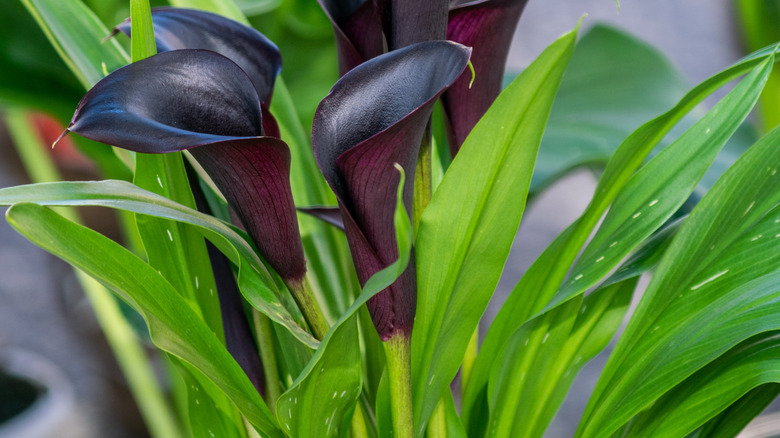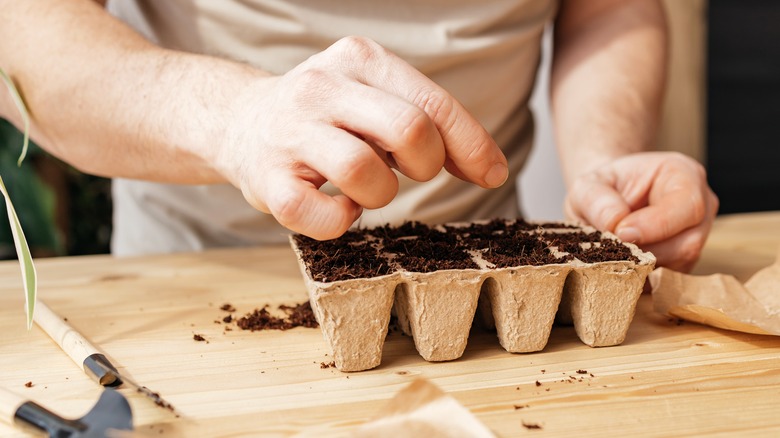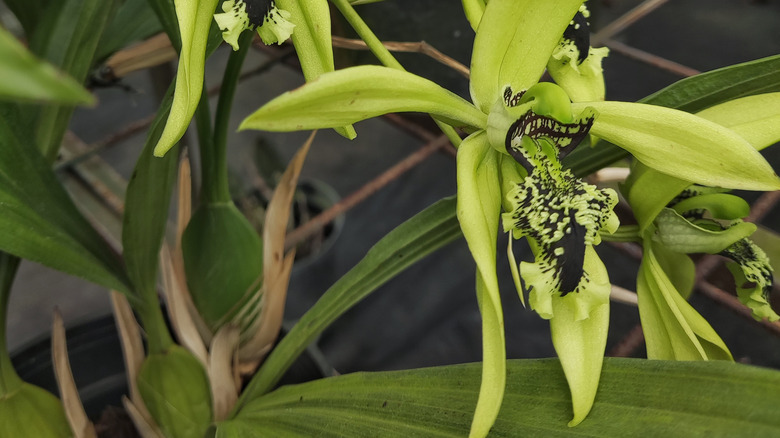You Can Grow A Rare Black Orchid Flower From Seed. Here's How
Imagine fancy types of orchids that make easy houseplants but can still thrive outdoors. Your home can steal the spotlight with the black orchid flower, a beautiful bloom with dark petals. This rare gem is all about that dark glam, flaunting waxy, glossy flowers so purplish-black they're like something out of a Gothic fairy tale. As for growing a black orchid flower from seed, it can be a bit of a project but super rewarding. Kick things off by sprinkling those almost microscopic seeds on the surface of a sterile, fluffy, and damp potting mix. Warmth is the seeds' wake-up call, setting the stage for the upcoming sprouts to eventually be transitioned into their own spaces where they'll shine independently.
If you are thinking of adding a dash of mystery to your garden edges or an enigmatic centerpiece to your living room, black orchid flowers are a no-brainer. However, growing them from seed is more than getting those little green sprouts to pop up. Think of the initial victory as the kick-off of a loving (and sometimes taxing) affair with their upkeep, often necessitating fine-tuning their environment for high humidity to light and warding off fungal diseases, mealybugs, and scale infestations. Though there's something we should probably get straight — these flowers aren't exactly pitch black. They're so deeply soaked in color that they trick the eyes into perceiving black in every petal.
How to start a black orchid flower from seed
Getting your hands on quality seeds from a reputable seller is your golden ticket to a successful orchid-growing adventure. Then, whip up a blend of course bark and sphagnum moss. It's like the perfect pizza crust for your orchid seed — not too soggy, not too dry. Plus, you'll want this blend sterile — trust us, you do not want fungal pathogens crashing the party. Ace this step by adding the mix into a squeaky-clean container.
Now come the fun bit: sowing the seeds. Black orchid seeds are super tiny, so you do not need to tuck them under. A sprinkle over the tip of the potting mix will do. Here's a little secret to make them feel right at home: mimic the vibes of a tropical rainforest by keeping the container's humidity high under a clear plastic lid or humidity dome. Then, scope out a corner indoors that basks in gentle, indirect light for your sealed botanical nursery, aiming for temperatures between 56 to 80 degrees Fahrenheit.
Be patient, though; it can take a spell to notice any signs of life. Part of caring for your indoor orchids is transferring those sprouts with a few true leaves and seem hardy enough to individual pots. Stick with the same medium you started with — garden soil won't cut for your young black orchids. Regarding easing them into the outdoors, it takes a bit of finesse, starting in deep shade and moving to lighter shade.
Caring for your black orchid flowers
Direct sunlight is a recipe for leaf damage — somewhere between partial and full shade is their ideal spec. Now, when it comes to watering, you must strike a balance. Too much and you've basically sent out invites for fungal issues and rot. Too little is just as bad. The trick is to hydrate your plants once the potting medium dries out, without letting the roots sit in a puddle.
Black orchids aren't the type to get all hangry, but they do appreciate some fertilizer during their growth spurts. And, just like us, these flowers sometimes outgrow their home. You'll know it's time for a move when you see their roots trying to break free. When that happens, pick a new, sterilized pot that fits their roots. Aim to do this house switch every couple of years, giving them fresh potting mix each time.
Snipping off the stalks when the flowers fade isn't just for looks; it encourages the orchids to get back into the blooming groove. Generally, you want to avoid pruning unless you're dealing with leaves that have seen better days. As the cooler months roll in and night temperatures start dipping below 50 degrees Fahrenheit when the sun sets, take your plants back inside whenever the sun sets. Lastly, keep your eyes peeled for aphids, scale, and mealy bugs. Neem oil, insecticidal soap, and horticultural oil are your go-to bouncers for tacking pests to keep them from destroying your orchids.


